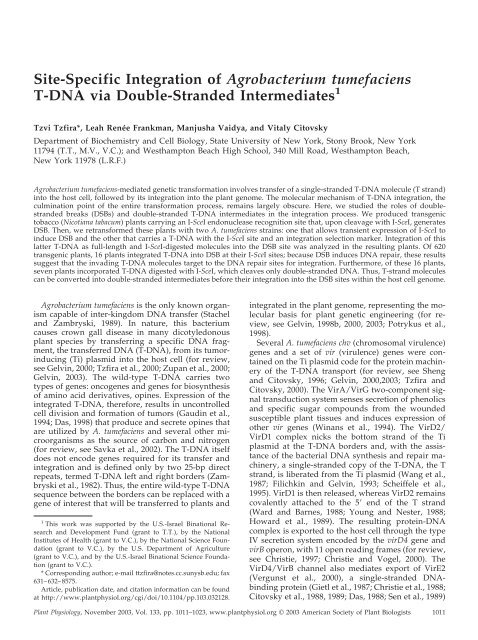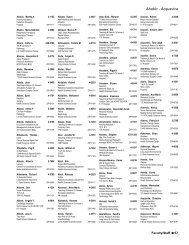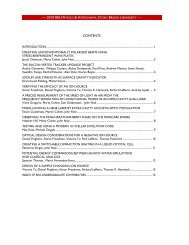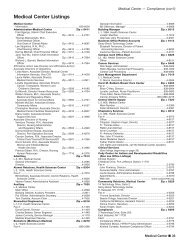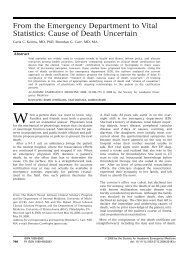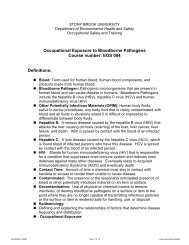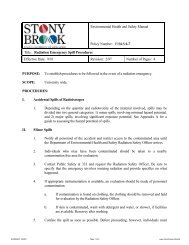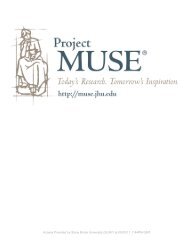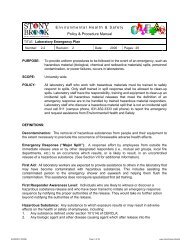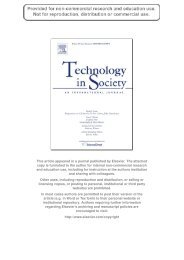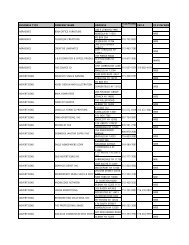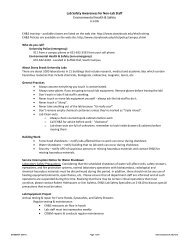Plant Physiology - Stony Brook University
Plant Physiology - Stony Brook University
Plant Physiology - Stony Brook University
Create successful ePaper yourself
Turn your PDF publications into a flip-book with our unique Google optimized e-Paper software.
Site-Specific Integration of Agrobacterium tumefaciens<br />
T-DNA via Double-Stranded Intermediates 1<br />
Tzvi Tzfira*, Leah Renée Frankman, Manjusha Vaidya, and Vitaly Citovsky<br />
Department of Biochemistry and Cell Biology, State <strong>University</strong> of New York, <strong>Stony</strong> <strong>Brook</strong>, New York<br />
11794 (T.T., M.V., V.C.); and Westhampton Beach High School, 340 Mill Road, Westhampton Beach,<br />
New York 11978 (L.R.F.)<br />
Agrobacterium tumefaciens-mediated genetic transformation involves transfer of a single-stranded T-DNA molecule (T strand)<br />
into the host cell, followed by its integration into the plant genome. The molecular mechanism of T-DNA integration, the<br />
culmination point of the entire transformation process, remains largely obscure. Here, we studied the roles of doublestranded<br />
breaks (DSBs) and double-stranded T-DNA intermediates in the integration process. We produced transgenic<br />
tobacco (Nicotiana tabacum) plants carrying an I-SceI endonuclease recognition site that, upon cleavage with I-SceI, generates<br />
DSB. Then, we retransformed these plants with two A. tumefaciens strains: one that allows transient expression of I-SceI to<br />
induce DSB and the other that carries a T-DNA with the I-SceI site and an integration selection marker. Integration of this<br />
latter T-DNA as full-length and I-SceI-digested molecules into the DSB site was analyzed in the resulting plants. Of 620<br />
transgenic plants, 16 plants integrated T-DNA into DSB at their I-SceI sites; because DSB induces DNA repair, these results<br />
suggest that the invading T-DNA molecules target to the DNA repair sites for integration. Furthermore, of these 16 plants,<br />
seven plants incorporated T-DNA digested with I-SceI, which cleaves only double-stranded DNA. Thus, T-strand molecules<br />
can be converted into double-stranded intermediates before their integration into the DSB sites within the host cell genome.<br />
Agrobacterium tumefaciens is the only known organism<br />
capable of inter-kingdom DNA transfer (Stachel<br />
and Zambryski, 1989). In nature, this bacterium<br />
causes crown gall disease in many dicotyledonous<br />
plant species by transferring a specific DNA fragment,<br />
the transferred DNA (T-DNA), from its tumorinducing<br />
(Ti) plasmid into the host cell (for review,<br />
see Gelvin, 2000; Tzfira et al., 2000; Zupan et al., 2000;<br />
Gelvin, 2003). The wild-type T-DNA carries two<br />
types of genes: oncogenes and genes for biosynthesis<br />
of amino acid derivatives, opines. Expression of the<br />
integrated T-DNA, therefore, results in uncontrolled<br />
cell division and formation of tumors (Gaudin et al.,<br />
1994; Das, 1998) that produce and secrete opines that<br />
are utilized by A. tumefaciens and several other microorganisms<br />
as the source of carbon and nitrogen<br />
(for review, see Savka et al., 2002). The T-DNA itself<br />
does not encode genes required for its transfer and<br />
integration and is defined only by two 25-bp direct<br />
repeats, termed T-DNA left and right borders (Zambryski<br />
et al., 1982). Thus, the entire wild-type T-DNA<br />
sequence between the borders can be replaced with a<br />
gene of interest that will be transferred to plants and<br />
1 This work was supported by the U.S.-Israel Binational Research<br />
and Development Fund (grant to T.T.), by the National<br />
Institutes of Health (grant to V.C.), by the National Science Foundation<br />
(grant to V.C.), by the U.S. Department of Agriculture<br />
(grant to V.C.), and by the U.S.-Israel Binational Science Foundation<br />
(grant to V.C.).<br />
* Corresponding author; e-mail ttzfira@notes.cc.sunysb.edu; fax<br />
631–632–8575.<br />
Article, publication date, and citation information can be found<br />
at http://www.plantphysiol.org/cgi/doi/10.1104/pp.103.032128.<br />
integrated in the plant genome, representing the molecular<br />
basis for plant genetic engineering (for review,<br />
see Gelvin, 1998b, 2000, 2003; Potrykus et al.,<br />
1998).<br />
Several A. tumefaciens chv (chromosomal virulence)<br />
genes and a set of vir (virulence) genes were contained<br />
on the Ti plasmid code for the protein machinery<br />
of the T-DNA transport (for review, see Sheng<br />
and Citovsky, 1996; Gelvin, 2000,2003; Tzfira and<br />
Citovsky, 2000). The VirA/VirG two-component signal<br />
transduction system senses secretion of phenolics<br />
and specific sugar compounds from the wounded<br />
susceptible plant tissues and induces expression of<br />
other vir genes (Winans et al., 1994). The VirD2/<br />
VirD1 complex nicks the bottom strand of the Ti<br />
plasmid at the T-DNA borders and, with the assistance<br />
of the bacterial DNA synthesis and repair machinery,<br />
a single-stranded copy of the T-DNA, the T<br />
strand, is liberated from the Ti plasmid (Wang et al.,<br />
1987; Filichkin and Gelvin, 1993; Scheiffele et al.,<br />
1995). VirD1 is then released, whereas VirD2 remains<br />
covalently attached to the 5� end of the T strand<br />
(Ward and Barnes, 1988; Young and Nester, 1988;<br />
Howard et al., 1989). The resulting protein-DNA<br />
complex is exported to the host cell through the type<br />
IV secretion system encoded by the virD4 gene and<br />
virB operon, with 11 open reading frames (for review,<br />
see Christie, 1997; Christie and Vogel, 2000). The<br />
VirD4/VirB channel also mediates export of VirE2<br />
(Vergunst et al., 2000), a single-stranded DNAbinding<br />
protein (Gietl et al., 1987; Christie et al., 1988;<br />
Citovsky et al., 1988, 1989; Das, 1988; Sen et al., 1989)<br />
<strong>Plant</strong> <strong>Physiology</strong>, November 2003, Vol. 133, pp. 1011–1023, www.plantphysiol.org © 2003 American Society of <strong>Plant</strong> Biologists 1011


